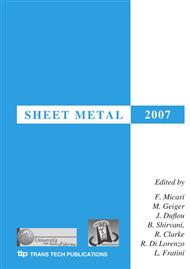p.225
p.235
p.243
p.251
p.259
p.269
p.277
p.285
p.293
A Comparative Method of Analysis for Evaluating Sheet Metal Machine Tool Flexibility
Abstract:
In the machine tool sector, for production purposes, flexibility and automation are elements that play conflicting roles because greater automation generally means less flexible production. As a result, it is not easy to choose between technologies that have different degrees of automation or may even be manual. We are therefore proposing a comparative method of analysis that can be used to evaluate one machine tool with respect to another, which is used as a reference. This combination leads to the identification of breakeven points on productivity, flexibility and automation that, when taken together, provide criteria for evaluating the economic suitability or unsuitability of the choice in hand. This comparative model rotates around evaluation variables that have long been consolidated and recognized by sheet metal machine tool manufacturers and users.
Info:
Periodical:
Pages:
259-268
Citation:
Online since:
July 2007
Authors:
Keywords:
Price:
Сopyright:
© 2007 Trans Tech Publications Ltd. All Rights Reserved
Share:
Citation:


